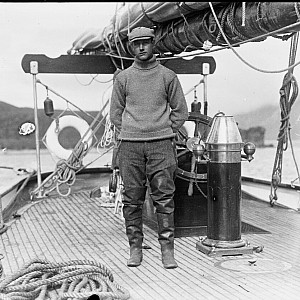Wright Museum spotlights James V. Lamb’s satirical and humorous art

Wright Museum of Art at Beloit College has launched the largest solo exhibit of works by James V. Lamb, a visual storyteller who brought satire and truth to his art.
Lamb moved his family to Beloit in 1966 and became a beloved part of the community.
After a life-altering heart attack and an early retirement, Lamb began to paint in the style of Grandma Moses but quickly developed a storytelling style truly his own. Drawing from his observations on society and inner fears, Lamb’s paintings depict satire and truth using garish colors and often unsettling characters.

“Collectively, these paintings tell us more than their individual narratives. They shed light on the thoughts, wit, and passions of an artist—one who was both eccentric and excessive,” says Wright Museum of Art Interim Director Christa Story.
Lamb’s large, colorful paintings are filled with humorous art historical references: the restocking of Warhol’s Coke-a-Cola, a fly swatted from a Miró, and a museum guard shooting back at a bow and arrow wielding putti.
David Wachtendonk, the artist’s grandson, had digitized dozens of slides and was just as enthusiastic about the paintings. He sent the artist’s ledger to Beloit—gold, to a curator like Story. The meticulous businessman-turned-artist cataloged his paintings, and the names of those who acquired works, by gift or purchase. Fast forward three years and the ledger, David, and his family helped track down almost half of Lamb’s 225 paintings nearly three decades after his death.
Lamb’s prolific painting output was a result of an excess of ideas. He wrote, “For 10 years I have about 100 paintings covering childhood memories, views of life, interesting people, reactions to art I’ve seen, and situations that have moved me deeply. I have enough ideas for about 20-30 a year, and my wife wants to clear out the storage area.”
Lamb jotted these ideas down in small notepads. Story says, flipping through, one gets a sense of initial thoughts, as well as fully composed paintings. In addition to the painting, each is accompanied by a narrative—some elaborate tales, others quick one-liners.
In retirement, Lamb said he finally had time to do something aside from making money, and that he now could have control over “what, how, when”. He wrote that his brother, early on, called him “Grandpa Moses”—eccentric or perhaps, “off.”
Though Lamb wasn’t a trained artist, Story says he possessed a skill that artists thrive on: observation. His decades of travel, reading and growing up in the motion picture industry-inspired ideas, as well as a deep interest in society.
“He asked questions and honed in on both personal and collective thoughts and fears. With these moralizing paintings, Lamb bewildered, amused, and sometimes irritated his audiences,” Story says.

Soon after Lamb began painting, he enrolled in an art appreciation class at the University of Wisconsin-Rock County where he met Everett Scott, who told him to “keep painting but to not ruin his personal vision by taking classes.”
Artist David Lundahl, who was teaching at Beloit College, was the first to critique Lamb’s art. Although it wasn’t positive, Lamb took the advice to paint from within, using feelings and experiences.
In soliciting galleries, Lamb said, “My pictures are commentaries on contemporary society and recognizable biblical events, wrapped in pathos surrounded by humor.”

By the early nineties, most of Lamb’s paintings were overtly religious. Whether they parody biblical stories or depict the age-old misunderstanding of men and women, these paintings helped Lamb work through his own questions of faith. Attending both Unitarian and Presbyterian churches for most of his life, Lamb never shied away from Theological discussion.
James Lamb and his family knew he was living on borrowed time after his major bypass surgery in 1974. When he began painting from his personal experience, post-Grandma Moses style, themes of life and death abound.
“Painting consumed his last decade and was, in many ways, a method of immortalizing his family, passions, and thoughts while intently focusing on his life,” Story says. “One thing we can assume from his work is: He wasn’t quite sure where the afterlife would take him.”


